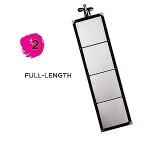Best Way to Remove Large Mirrors Glued to a Wall
Removing a large mirror glued to a wall can be a daunting task. Improper removal can lead to damaged walls, broken mirrors, and potential injury. This guide provides a safe and effective approach to this challenging project.
Assessing the Situation
Before beginning the removal process, careful assessment is crucial. Different adhesives require different removal techniques. Understanding the type of wall and the mirror's weight also informs the strategy.
- Identify the adhesive: Common adhesives include construction adhesive, mirror mastic, and double-sided tape. Knowing the adhesive type helps determine the appropriate solvent or removal method.
- Determine wall type: Drywall requires more caution than plaster or concrete walls due to its fragility.
- Evaluate mirror size and weight: Larger, heavier mirrors require more support during removal and may necessitate additional assistance.
Gathering Necessary Tools and Materials
Having the right tools and materials at hand ensures a smooth and efficient removal process. Improvisation with inadequate tools can increase the risk of accidents and damage.
- Heavy-duty gloves: Protect hands from sharp edges and chemicals.
- Safety glasses: Shield eyes from flying debris.
- Drop cloths or blankets: Cover the floor to protect it from falling glass shards.
- Putty knife or thin wire: Used to work behind the mirror and break the adhesive bond.
- Suction cups: Provide a secure grip for maneuvering the mirror.
- Duct tape: Supports the mirror during removal and helps prevent shattering.
- Solvent (e.g., adhesive remover, rubbing alcohol, or WD-40): Dissolves or weakens the adhesive.
- Hammer or pry bar (if necessary): Used with caution for stubborn adhesives.
- Utility knife: Scores resilient adhesives or tape.
Preparing the Work Area
Proper preparation minimizes the risk of damage and injury. Creating a safe and controlled environment is essential for a successful outcome.
- Clear the area: Remove any furniture or obstacles that might obstruct movement or be damaged during the removal process.
- Cover the floor: Lay down drop cloths or blankets to protect the floor and catch any falling glass.
- Apply duct tape to the mirror surface: Create a grid pattern with duct tape to help hold the mirror together and prevent shattering if it cracks.
Weakening the Adhesive
Breaking down the adhesive bond simplifies the removal process and reduces the risk of damage to both the mirror and the wall.
- Identify adhesive type: Select the appropriate solvent based on the adhesive used.
- Apply solvent: Carefully apply the solvent behind the mirror using a putty knife or thin wire. Allow sufficient time for the solvent to penetrate and weaken the adhesive.
- Test a small area first: Before applying solvent to the entire area, test it on a small, inconspicuous section to ensure it doesn't damage the wall or mirror finish.
Separating the Mirror from the Wall
Once the adhesive is sufficiently weakened, carefully begin separating the mirror from the wall. Patience and controlled movements are key to preventing damage.
- Use suction cups: Attach suction cups to the mirror's surface to provide a secure grip.
- Gently pry: Carefully insert a putty knife or thin wire behind the mirror and slowly work it back and forth to break the adhesive bond. Gradually increase the pressure as the mirror loosens.
- Work in sections: Divide the mirror into sections and work on one section at a time to prevent the mirror from cracking or shattering.
- Enlist assistance: For large or heavy mirrors, have another person assist with supporting and maneuvering the mirror during removal.
Repairing the Wall
After removing the mirror, the wall will likely require some repair. Depending on the adhesive used and the wall type, different repair methods may be necessary.
- Remove adhesive residue: Use a scraper or putty knife to carefully remove any remaining adhesive from the wall.
- Patch and sand: Repair any holes or damage to the wall with spackling compound. Once dry, sand the area smooth.
- Repaint: Apply a fresh coat of paint to blend the repaired area with the surrounding wall.
Disposing of the Mirror
Proper disposal of the removed mirror ensures safety and environmental responsibility.
- Wrap the mirror: Carefully wrap the mirror in thick cardboard or blankets to prevent injuries during handling and transport.
- Label clearly: Mark the package clearly as "broken glass" to warn others of the potential hazard.
- Check local regulations: Consult local waste disposal regulations for proper disposal methods.

How To Remove A Mirror Glued The Wall Forbes Home

How To Safely And Easily Remove A Large Bathroom Builder Mirror From The Wall Site Title

How To Safely And Easily Remove A Large Bathroom Builder Mirror From The Wall Site Title

How To Safely And Easily Remove A Large Bathroom Builder Mirror From The Wall Site Title

How To Remove A Bathroom Mirror Lowe S

How To Safely And Easily Remove A Large Bathroom Builder Mirror From The Wall Site Title

How To Remove A Frameless Mirror Like Nervous Grandma

How To Safely Remove A Wall Mirror Diy Network

How To Remove A Glued Bathroom Mirror From The Wall

How To Remove Mirror Off Wallsafely








